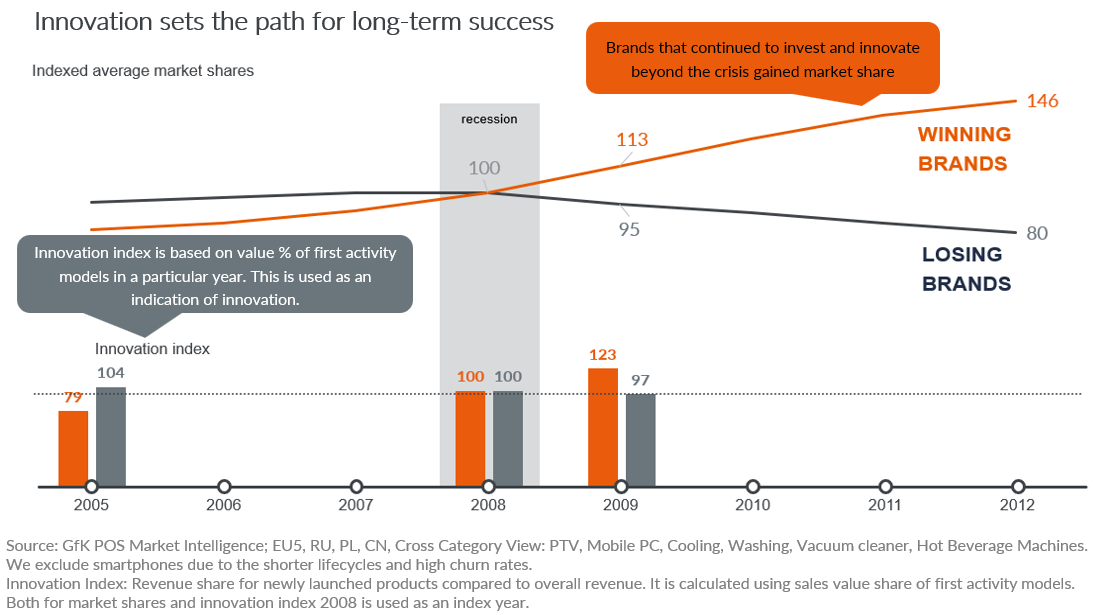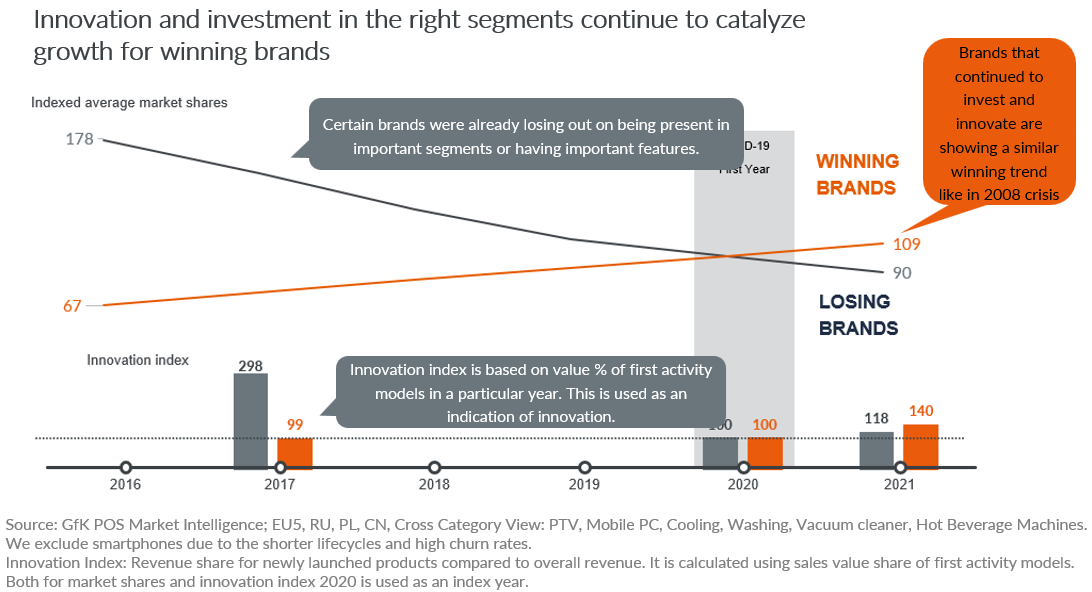Creating the next game-changing product or disruptive solution is often touted as the greatest height a brand can achieve. But product innovation isn’t just about big changes – it is often the incremental progress that steadily adds features, convenience and performance that is more important. In fact, history shows that brands that continually invest in innovation perform better over the course of market downturns. As we head deeper into a new period of market uncertainty, it could become a key factor in preserving growth.
Innovation in the face of uncertainty
Crisis creates opportunities. In times of uncertainty, established hierarchies can reorder, dominant strategies can flounder, and new ideas have a chance to gain a foothold. But supporting and enabling innovation is not simple. It requires the right skills, culture, strategy and vision. Following the 2008 recession, it was brands that continued to invest in innovation beyond the crisis that gained market share in the years that followed. As the world economy began emerging from the COVID-related disruption of 2020 it is again the brands that have invested in innovating that are winning.


In the small domestic appliances (SDA) market, Asian and US brands have displayed an ability to bounce back faster than peers in other markets in previous crises as well as post-pandemic. There are several characteristics that may explain this. These include more investment and financial power from the brand or brand group and shorter innovation cycles. However, the biggest indicator of success is operating in the right segments at the right time. Simple enough in theory but incredibly difficult to achieve in practice. In the major domestic appliances (MDA) market, Asian and newcomer brands have also historically benefited from crises, with Korean brands, in particular, challenging established players during the Great Recession of 2008/09. Chinese brands have been the rising MDA stars post-pandemic, selling 84% more units in the first five months of 2022 compared with the same period in 2019, although they remain minor players in the market.
Consumers value great features, functionality and improved performance
Functionality and features are a major part of most people’s purchasing decisions. For vacuum cleaners, for example, 64% of consumers choose a product based on its features – compared to 54% that choose based on brand and 37% that use price as the primary factor.
A relevant use case is critical for mass adoption; brands have to understand consumer needs and make their lives easier. Handstick and handheld vacuum cleaners, for example, are proving particularly popular thanks to their convenience, with the former seeing a 37% growth between 2021 and 2022 versus the previous years. Smart lighting and washing machines with drum clean programs grew by 3% and 21% respectively in the first quarter of 2022 whereas standard versions slumped in value. Likewise, built-in hobs with an integrated hood significantly outperformed separate built-in hobs and hoods in Q1 2022, growing by 42%.

When it comes to consumer electronics (CE), people are prepared to pay for a performance boost. In the first quarter of 2022, 5G phones grew by 75% on the previous year and NVME (non-volatile memory express) 1TB SSD grew by 9% from January to October 2022. Similarly, demand for high performance laptop computers has grown in 2022.

The importance of simplifying daily activities can be seen in the growth of smart home product categories in recent years, especially those with voice activation features. In the EU7, sales of smart home automation products totaled $20.0 billion between January and September 2022, with voice activation being the preferred form of control for two out of three consumers.
In fact, voice control has already become a baseline for some categories, valued by consumers for the convenience benefit. For other categories, it is still a growth feature.

The main barriers to further adoption of smart home products also relate to simplification: 53% of UK consumers see compatibility with other devices as a key priority, 51% that it should be easy to use and 45% that it will make daily life easier.
Conversely, the eat@home trend, which saw consumers snap up appliances that made food preparation simpler during the pandemic, and even post-lockdown, is now subsiding. Following an extraordinary 15 months of sales, food processors were down by 20% in H1 2022 while choppers and liquidizers saw a slump of 13% and 5% respectively.
Innovative strategies
An effective product innovation strategy doesn’t just relate to product improvement through design. It is an important consideration for the way products are marketed and sold too. But often the central resource is customer data and insight. Innovation without an understanding of consumer needs, behavior and preferences is not going to be as effectively targeted as it could be. Having an omnichannel brand presence and reach is also increasingly not only a ‘nice to have’ but a requirement to compete.
The rise of social selling in China is an example of innovation in retail touchpoints for marketing as well as selling, creating big results for brands. With more consumers across the world researching and purchasing products online and through social media – there is a distinct opportunity for brands to get creative with the ways they engage current or potential customers. For example, 62% of consumers spend between 30-60 minutes researching a new hairdryer and 49% are willing to swap brands. With an increasing amount of this research being done on social media, focusing on these platforms could be a winning strategy.
It’s a marathon, not a sprint
For consumers, innovation is not always about the technical aspects of a product’s design or functionality. Often it comes down to whether it is easy to use and solves a specific need in their lives. It doesn’t have to be a huge game-changer either. For many people, simply being able to ask for information they need, such as cooking conversions or to set a timer, without having to stop what they are doing can have a profound impact on everyday activities like food preparation or listening to music. Understanding the needs of customers, as well as how they evolve over time, and finding the right way to communicate are essential components of innovation. Moving forward, brands should continue to think of industrial innovation competition as a long-term play and create a culture to support it.
Innovation requires insight and the right strategy. That’s where gfkconsult can provide real value.

![Understanding your audience: The power of segmentation in retail [podcast]](https://nielseniq.com/wp-content/uploads/sites/4/2025/07/Podcast-Understanding_your_audience-The_power_of_segmentation_in_retail-mirrored.jpg?w=1024)

